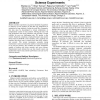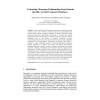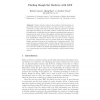921 search results - page 83 / 185 » Feature selection in scientific applications |
HPDC
2010
IEEE
13 years 11 months ago
2010
IEEE
Modern scientific experiments can generate hundreds of gigabytes to terabytes or even petabytes of data that may furthermore be maintained in large numbers of relatively small fil...
CORR
2006
Springer
13 years 10 months ago
2006
Springer
This paper presents a new functionality of the Automatic Differentiation (AD) Tool tapenade. tapenade generates adjoint codes which are widely used for optimization or inverse prob...
NLDB
2010
Springer
13 years 8 months ago
2010
Springer
Abstract. Various techniques for learning meronymy relationships from opendomain corpora exist. However, extracting meronymy relationships from domain-specific, textual corporate d...
BMCBI
2008
13 years 10 months ago
2008
Background: Molecular typing methods are commonly used to study genetic relationships among bacterial isolates. Many of these methods have become standardized and produce portable...
RSFDGRC
2005
Springer
14 years 3 months ago
2005
Springer
Abstract. Feature selection refers to the problem of selecting those input features that are most predictive of a given outcome; a problem encountered in many areas such as machine...



